Olympian Gods – The Ancient Greek Pantheon
Who were the 12 Olympian gods and goddesses, and what role did they play in the Greek pantheon? That is the main question of today’s article on the gods of Olympus. We will, however, also be looking at the 15 other gods that may not technically be Mount Olympus Gods, but are also regarded as Olympians due to their association with the 12 Olympian gods and goddesses. Join us as we find out more about the gods of Olympus and their significance to the ancient Greeks.
Exploring the Olympian Gods and Goddesses
The Olympian gods and goddesses were a race of powerful deities worshiped as the primary gods of the Greek pantheon. They took their name from the divine order established by the sky-god Zeus who made his home on the highest peak in Greece on Mount Olympus. The Olympian gods rose to power after a decade-long war between the old order of gods and the new one. Zeus led his brothers and sisters to triumph over the preceding generation of ruling gods, the Titans, who were themselves progeny of the primordial race of gods headed by Gaia and Uranus.
 Mount Olympus from Larissa, Thessaly, Greece by Edward Lear (1848-88); Edward Lear, CC0, via Wikimedia Commons
Mount Olympus from Larissa, Thessaly, Greece by Edward Lear (1848-88); Edward Lear, CC0, via Wikimedia Commons
The 12 Olympian Gods and Goddesses
Before the Olympians ruled, the governing powers were the second generation of gods known as the Titans. The Olympian order was established by the sons and daughters of the Titans Cronus and Rhea. Zeus’ new divine order was significant for marking the end of a pattern where the ruling god killed or oppressed his offspring only to be overthrown by one of his sons.
 Fragment of a relief depicting the twelve Olympian gods. From left to right: Hestia, Hermes, Aphrodite, Ares, Demeter, Hephaestus, Hera, Poseidon, Athena, Zeus, Artemis, and Apollo (c. 1st Century BCE to 1s Century CE); Walters Art Museum, Public domain, via Wikimedia Commons
Fragment of a relief depicting the twelve Olympian gods. From left to right: Hestia, Hermes, Aphrodite, Ares, Demeter, Hephaestus, Hera, Poseidon, Athena, Zeus, Artemis, and Apollo (c. 1st Century BCE to 1s Century CE); Walters Art Museum, Public domain, via Wikimedia Commons
The exact makeup of the pantheon of the top twelve Olympians changes depending on various ancient sources, but some names retain their prominence across the board. Other gods may technically be Titans, demi-gods, and lesser divinities, but the popularity of their cults in antiquity meant that they ended up playing significant roles in Greek myth and became closely associated with the Olympians.
The number of Olympians as twelve most likely derives from ancient cult practices. In ancient Greek sanctuaries, altars were provided for a variety of gods associated with that specific location. Amongst these altars would be one dedicated to “All Gods”. Such altars would often be decorated with inscriptions or depictions of a set of twelve deities meant represent the entire pantheon.
 Altar or well featuring depictions of the twelve gods with Zodiac symbols. The gods depicted are the Roman versions Aphrodite, Ares, Zeus, Athena, Apollo, Hera, Poseidon, Hephaestus, Hermes, Hestia, Artemis, and Demeter (1st Century CE); Louvre Museum, Public domain, via Wikimedia Commons
Altar or well featuring depictions of the twelve gods with Zodiac symbols. The gods depicted are the Roman versions Aphrodite, Ares, Zeus, Athena, Apollo, Hera, Poseidon, Hephaestus, Hermes, Hestia, Artemis, and Demeter (1st Century CE); Louvre Museum, Public domain, via Wikimedia Commons
The most traditional Olympian gods lineup consisted of Zeus and his brothers Poseidon and Hades; their sisters Hera, Demeter, and Hestia; followed by Zeus’ children Athena, Apollo, Artemis, Ares, Hephaestus, and Aphrodite. There were notable variants of this list though: the name of Hades as god of the dead could not be spoken for fear of invoking him, making room for Hermes. Also, at some point the immense popularity and broad civic participation in the cult of the “newcomer” Dionysus saw him replace Hestia as one of the twelve main gods.
Zeus
Where better to start our list than with the King of the Mount Olympus gods himself, the mighty Zeus? But why is Zeus regarded as the god’s king in the first place? Was he perhaps the first-born offspring of the Titans Cronus and Rhea? Well, surprisingly, he was actually the last to be born of all his brothers and sisters, but luckily escaped their fate by being hidden by his mother at birth. Chronos had eaten all of his other offspring at birth in fear that one of them would one day dethrone him. When Zeus was old enough, he went to Chronos and made him regurgitate all of the other Olympian gods and goddesses. This resulted in a war where the Titans were overthrown by the Olympians.
Zeus and his two brothers divided up the world between them. Zeus as the sky-god took control of the earth, Poseidon took possession of the oceans, and Hades became king of the underworld.
 Woman with a statue of Zeus from Four Captives by Mertin Desjardins (1679-1682); Carl Purcell, CC BY-SA 3.0, via Wikimedia Commons
Woman with a statue of Zeus from Four Captives by Mertin Desjardins (1679-1682); Carl Purcell, CC BY-SA 3.0, via Wikimedia Commons
Hera
Since we started with the Olympian gods’ king, it makes sense to next introduce his bride, the queen of the gods, Hera. Not only was Hera the wife of Zeus, but his sister too – quite a frequent occurrence in the realm of the gods. She was known for her exceptional beauty but was equally renowned for her vengeful nature and bouts of jealousy. One cannot really blame her, though, given that Zeus as the fertility-inducing god of thunder felt the need to spill his sacred seed wherever possible.
Many myths involve Hera (usually due to her conflicts with Zeus’ lovers and illegitimate children), however, she was still regarded as a highly respected figure among the other Olympian gods and goddesses.
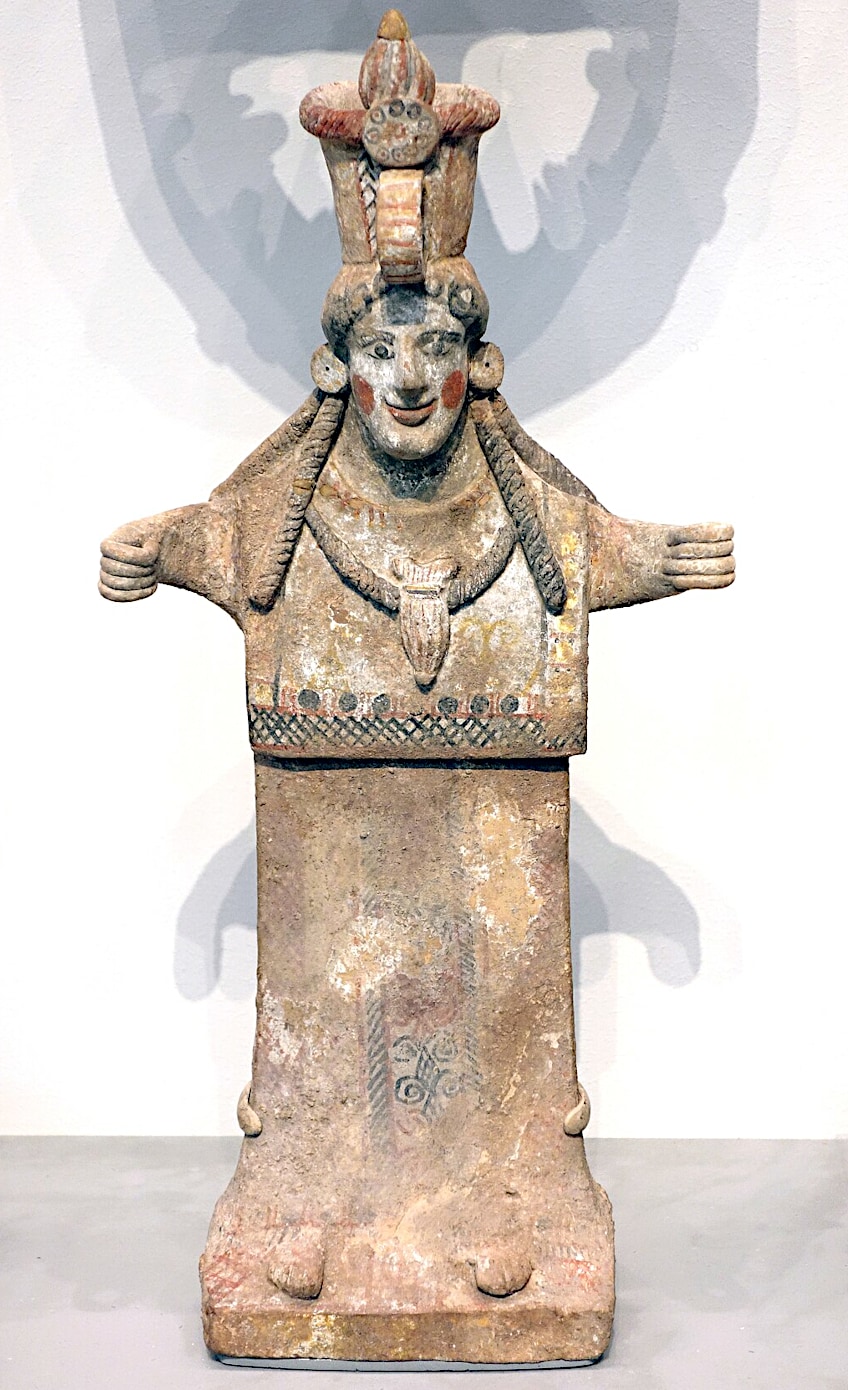 Boeotian “plank idol” with polos, possibly depicting Hera (late 6th Century BCE); Mark Landon / Wikimedia Commons
Boeotian “plank idol” with polos, possibly depicting Hera (late 6th Century BCE); Mark Landon / Wikimedia Commons
As one of the most ancient Greek deities, Hera was revered as the protector of married women who presided over childbirth and weddings, and was the mother of such prominent Olympian divinities as Ares, Hephaestus, and Hebe. In some myths she was also mother to the graceful Charites, the witch queen Hecate, and the ultimate troublemaker Eris.
Aphrodite
One of the most well-known Olympian deities is surely the goddess of love, Aphrodite. Often depicted in the company of Eros, she is portrayed as a very attractive woman who is also regarded as the goddess of pleasure, procreation, and beauty. You might also recognize her by her Roman name, Venus.
 Gilt Bronze mirror engraved with Aphrodite and Eros (c. 350 BCE); AnonymousUnknown author, Public domain, via Wikimedia Commons
Gilt Bronze mirror engraved with Aphrodite and Eros (c. 350 BCE); AnonymousUnknown author, Public domain, via Wikimedia Commons
Her birth story has been illustrated in famous paintings, and her various affairs are legendary, such as her relationship with the god of war, Ares.
According to some versions, her birth occurred when her father, Uranus’ genitals were cut off by his sons Cronos and then thrown into the ocean. Aphrodite emerged from the foam that resulted from his genitalia thrashing in the surf. In other versions, Aphrodite was the Daughter of Zeus and Dione, a goddess of the first generation. Some of Aphrodite’s symbols include roses, myrtle, doves, apples, bees, and swans.
Poseidon
Another of the Olympian gods to often feature in movies and stories is Poseidon, known as Neptune in the Roman era. Easily recognizable due to his three-pronged trident, Poseidon is the brother of Hades and Zeus and is the god of the sea. His domain of influence does not end there, though, as he is also regarded as the Greek god of earthquakes and horses. These associations are not inexplicable: the phenomenon of a tsunami following an earthquake was highly familiar in the ancient Mediterranean, while the white caps of waves were thought to resemble galloping horses. He is said to have complete control of the oceans, along with other bodies of water, as well as all the animals that dwell therein. Yet, he also has a large impact on the land itself as the god of earthquakes.
One of Poseidon’s most well-known myths is his legendary competition for the city of Athens against Athena, which he ultimately lost.
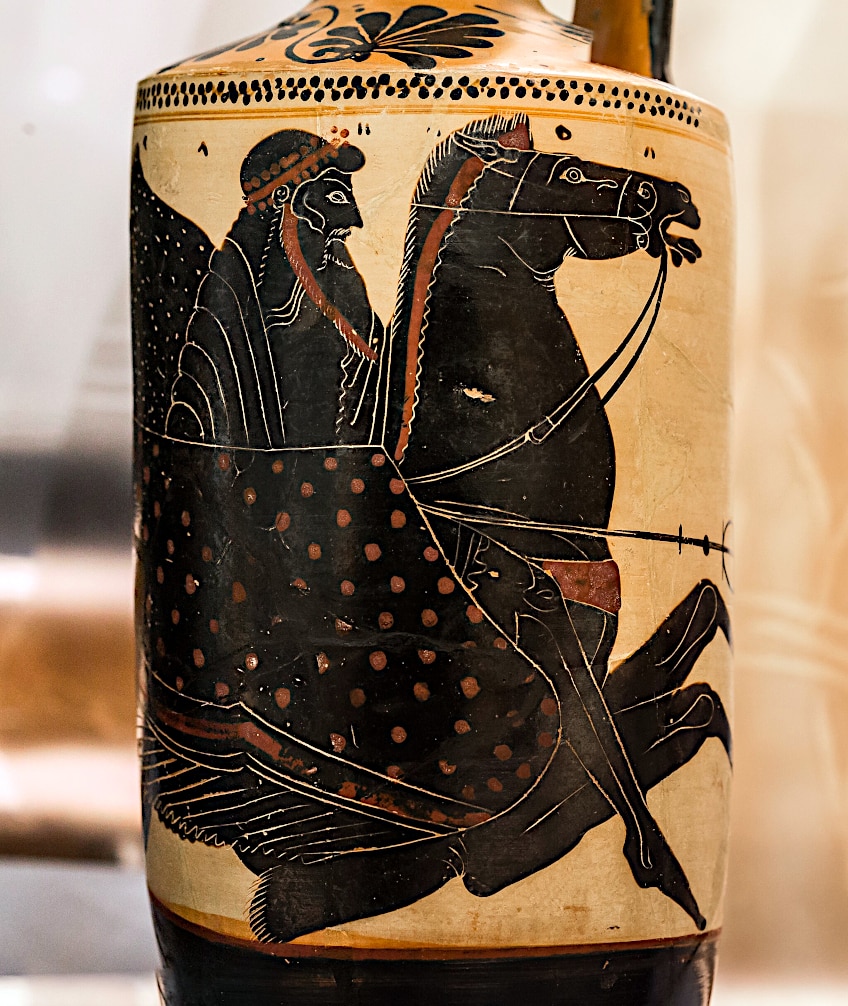 Attic black figure white ground lekythos with a depiction of Poseidon on a hippocamp (c. 500-480 BCE); ArchaiOptix, CC BY-SA 4.0, via Wikimedia Commons
Attic black figure white ground lekythos with a depiction of Poseidon on a hippocamp (c. 500-480 BCE); ArchaiOptix, CC BY-SA 4.0, via Wikimedia Commons
Apollo
Apollo is usually portrayed as a rather handsome and clean-shaven young man who had long hair. He was known as the Greek god of oracles, prophecy, archery, music, and healing from diseases and plagues. Apollo features in many Greek myths, such as when he slayed the Python which had guarded Delphi’s oracular shrine, and his musical competition with Marsayas, the satyr. In Greek mythology, this deity is often credited with the invention of both the flute and the lyre. He was also regarded as a protector of herds and flocks in some myths.
 Copy of a Fresco from Herculaneum depicting Apollo watching a female artist by Wilhelm Zahn (before 1871); Wilhelm Zahn (d. 1871), Public domain, via Wikimedia Commons
Copy of a Fresco from Herculaneum depicting Apollo watching a female artist by Wilhelm Zahn (before 1871); Wilhelm Zahn (d. 1871), Public domain, via Wikimedia Commons
His attributes include the lyre, the raven, arrows, and the laurel wreath. He was the offspring of Zeus and Leto, and the twin sister of Artemis, the Olympian goddess of hunting.
Artemis
Artemis is portrayed as a hunting goddess who punishes people who disrespect her. Artemis’ fury is symbolic of untamed nature’s hostility toward humans. Despite her position as a virgin who evaded possible partners, Artemis’ beauty is mentioned several times in Greek mythology. In some versions, she is the twin sister of Apollo, but in others, she was born before he was, or after.
 Cast of a (1st Century CE) Roman copy of a Greek sculpture depicting Artemis with polychromy reconstructed; Alaskanspaceship, CC BY-SA 4.0, via Wikimedia Commons
Cast of a (1st Century CE) Roman copy of a Greek sculpture depicting Artemis with polychromy reconstructed; Alaskanspaceship, CC BY-SA 4.0, via Wikimedia Commons
Artemis was regarded as the deity of hunting, child care, the wilderness, and vegetation. In Rome, she is known by the name, Diana.
In Greek mythology, she roamed the woodlands of the country, usually accompanied by her rather large entourage of people, consisting of various mortals, hunters, and nymphs. Artemis, along with Hera and Eileithyia, was revered as a prominent goddess of midwifery and childbirth.
Ares
Another of the more well-known Olympian gods is the god of violence and war, Ares, otherwise known by his Roman name, Mars. There are two typical depictions of this god, the one being a nude and clean-shaven youth, and the other being a more mature and bearded warrior. One of the most well-known myths featuring Ares is his lust for Hephaistos’ wife, the beautiful Aphrodite. However, their affair did not go as planned, when Hephaistos quite literally caught the two in the act using a magical net.
Upon their capture, they were exposed in front of all the other Olympian gods, who ridiculed them mercilessly. However, Ares himself would grow jealous after learning of Aphrodite’s feelings for Adonis, transforming himself into a boar, and gorging Adonis to death.
In Homer’s epic poem the Iliad, Zeus expresses his deep distaste for the brutal and unreliable Ares, telling him that had he not been his son, he would have imprisoned him even deeper in the earth than the Titans.
 Attic black-figured volute-krater showing Zeus intervening in a duel between Athena and Ares (c. 540–510 BCE); Nikosthenes Potter (signed), CC0, via Wikimedia Commons
Attic black-figured volute-krater showing Zeus intervening in a duel between Athena and Ares (c. 540–510 BCE); Nikosthenes Potter (signed), CC0, via Wikimedia Commons
Athena
Based on her name, you can probably deduct what her role was. If you guessed the patron of Athens, then you would be correct! However, she did not only protect this ancient city, but was the protecting goddess of many towns, as well as the deity in charge of wisdom, weaving, and other crafts. She was the goddess of strategic warfare and the protector and guide of heroes such as Odysseus, Achilles, Theseus, and others. Born from Zeus’ own head, she was also the favorite child and closest ally of the king of the gods.
Athena was portrayed as a dignified young woman equipped with a spear and shield, dressed in a long robe, crested headgear, and the infamous snake-trimmed cloak emblazoned with the terrifying visage of Medusa the Gorgon. The most famous statue of her was created from ivory and gold for the interior of the Parthenon by the sculptor Phidias.
 Modern recreation of Phidias’ lost colossal statue of Athena Parthenos by Alan Lequire (1990); Photograph by Dean Dixon, Sculpture by Alan LeQuire, FAL, via Wikimedia Commons
Modern recreation of Phidias’ lost colossal statue of Athena Parthenos by Alan Lequire (1990); Photograph by Dean Dixon, Sculpture by Alan LeQuire, FAL, via Wikimedia Commons
One of her most famous myths is about her competition with Poseidon for Athens. He created a water source for the local people, but it was salt water and proved useless to them. She produced an olive tree. As this would form the basis of Athens’ economy as an exporter of olive oil, Athena awarded the patronage of Athens.
Demeter
Demeter was a Greek goddess associated with farming, harvesting, and fertility. Demeter was mainly associated with crop agriculture and the seasons. She was in charge of the earth’s fertility and plentiful crops. Ceres, from whom the name “cereal” is derived, is her Roman name. The narrative of Demeter’s daughter, Persephone, is the most well-known myth connected with her. In the myth, Persephone had been kidnapped by Hades while collecting flowers. As she accidentally ate some pomegranate seeds while in the house of Hades, she was now his wife. In her sadness, Demeter neglected her duties, causing an immense famine, and the land became barren. Zeus ultimately intervened and arranged a settlement. Persephone would thus spend half of the year with Hades in the underworld and the other half with Demeter on Earth.
When she was gone in winter, the earth would be barren from Demeter’s sorrow, but when she returned in Summer, the land would grow fertile. This myth was used to explain the changing of the seasons. The rituals named the Eleusinian Mysteries that commemorated this myth were amongst the most famous in the ancient world.
 Votive plaque depicting the Eleusinian Mysteries (middle of the 4th Century BCE); No machine-readable author provided. Marsyas assumed (based on copyright claims)., CC BY-SA 3.0, via Wikimedia Commons
Votive plaque depicting the Eleusinian Mysteries (middle of the 4th Century BCE); No machine-readable author provided. Marsyas assumed (based on copyright claims)., CC BY-SA 3.0, via Wikimedia Commons
Dionysus
Basically, Dionysus was the person in the Olympian family who enjoyed partying and celebrating life. This is evident in his role as the god of wine and festivities, along with wildness and even moments of religious ecstasy. He is usually depicted wearing a crown of ivy, along with his pine cone-tipped staff and his drinking cup. He too, was depicted in multiple different ways, sometimes appearing as a mature god with a beard, and other times depicted as a long-haired and somewhat effeminate youth.
 Theatrical mask depicting Dionysus (between 2nd and 1st Century BCE); Louvre Museum, Public domain, via Wikimedia Commons
Theatrical mask depicting Dionysus (between 2nd and 1st Century BCE); Louvre Museum, Public domain, via Wikimedia Commons
Dionysus’ elevation to the top tier of the Olympian pantheon is unusual, given that his mother was a mortal named Semele. However, since Zeus implanted the unborn Dionysus into his thigh after Semele’s untimely death, he was technically born from a god.
The use of theatrical performances in Dionysian festivals, and their popularity as a form of social commentary and means of ensuring civic participation in Greek city-states meant that Dionysus went from a figure considered “foreign” in origin to one of the most quintessentially Hellenic gods.
Hephaestus
This Olympian god was renowned for his role as the god of fire and was also the deity of metalworking and blacksmiths. He was usually portrayed as a more mature bearded figure, often riding on a donkey’s back. While some traditions state that his father was Zeus, there are others that state that he actually was born without a father and that Hera gave birth to Hephaestus out of revenge for Zeus fathering Athena on his own. However, this contradicts the story where Hephaestus was actually the god that helped split Zeus’ head open to help Athena spring forth from his scalp.
He was known to be a rather unattractive god who was disabled and suffered facial deformities. However, he was also considered the most ingenious of all the gods and credited with creating the greatest marvels, such as the famed armor of Achilles.
 Red-figure kylix with a depiction of Thetis collecting the armor made for Achilles by Hephaestus (490-480 BCE); Altes Museum, Public domain, via Wikimedia Commons
Red-figure kylix with a depiction of Thetis collecting the armor made for Achilles by Hephaestus (490-480 BCE); Altes Museum, Public domain, via Wikimedia Commons
Hermes
Hermes was regarded as the Olympian god of travelers and hospitality, flocks and herds, trade and highways, shrewdness diplomacy, language, athletic competitions, astrology, and astronomy. He was Zeus’ personal messenger, as well as the guide of the deceased who escorted the departed into the underworld.
Hermes was usually portrayed as either an attractive and athletic beardless youngster or an older man with a herald’s wand and winged boots.
As a newborn, Hermes crept out of his cot, kidnapped Apollo’s cattle, and fashioned the first lyre from the shell of a turtle. Zeus was so delighted by the youthful god’s activities that he made him one of the twelve Mount Olympus gods. The herma, a stone road sign that functioned as a boundary marker, was another distinct symbol of the deity. The simplest hermae were plain, upright standing stones, while the most ornate were rectangular statuettes carved with Hermes’ head, genitals, and his herald’s wand.
 Campanian red-figure kalyx crater featuring a depiction of an altar of Hermes with a Herm (450 BCE); Zde, CC BY-SA 4.0, via Wikimedia Commons
Campanian red-figure kalyx crater featuring a depiction of an altar of Hermes with a Herm (450 BCE); Zde, CC BY-SA 4.0, via Wikimedia Commons
The Other Olympian Gods and Goddesses
Above, we discussed the main 12 Olympian gods and goddesses. However, they were not the only deities to inhabit this mythical realm. These other Mount Olympus gods were usually associated with the main 12 gods of Olympus in some way. Many of them served as minions for the main deities, for example, the Muses were commonly associated with Apollo, and Eros was frequently portrayed accompanying Aphrodite. But, what role did these other lesser Mount Olympus gods play in the Greek pantheon?
Asclepius
Asclepius was the Greek deity of medicine as well as patron of the ancient guild of physicians. He was Apollon’s son with Coronis, the Trikkaian princess.
Asclepius’ mother died in childbirth, and when she was about to be cremated on the pyre, Apollon removed the unborn child from Coronis. HIs name means “to cut open”, reflecting his unusual birth.
Chiron, the centaur who nurtured him, taught him his knowledge of medicine. He became so good at his profession that he was able to bring the dead back to life. This was a violation of the laws of nature, and Zeus punished him with a thunderbolt. After his eventual demise, Asclepius was reborn as the star constellation Ophiuchus. He was typically portrayed as a friendly, bearded individual carrying a snake-entwined staff. The cult of Asclepius often featured a figure named Hygeia who was either his daughter or his wife. She shared her name with Athena Hygeia who was the goddess Athena in her role as the protector of mental health.
 Statuettes of Asclepius and his daughter Hygeia (100-150 CE); Dave & Margie Hill / Kleerup from Centennial, CO, USA, CC BY-SA 2.0, via Wikimedia Commons
Statuettes of Asclepius and his daughter Hygeia (100-150 CE); Dave & Margie Hill / Kleerup from Centennial, CO, USA, CC BY-SA 2.0, via Wikimedia Commons
The Charites
These three goddess sisters were also commonly known as the Graces, and they were the Greek embodiment of grace, beauty, and charm. Aglaea embodied elegance, beauty, and ornamentation. She was typically associated with beauty and often appeared wearing exquisite clothing. Euphrosyne represented happiness and joy. She was identified with contentment and laughter, and she spread joy all around her. Thalia was a symbol of prosperity and celebration. She was connected with feasts, festivities, and the flowering of nature. She brought joy and fun to gatherings.
 Detail of the Three Graces or Charites from Primavera by Sandro Botticelli (c. 1485-1487); Sandro Botticelli, Public domain, via Wikimedia Commons
Detail of the Three Graces or Charites from Primavera by Sandro Botticelli (c. 1485-1487); Sandro Botticelli, Public domain, via Wikimedia Commons
The Charites were portrayed as charming and happy maidens who imparted beauty and pleasure unto the world. They were strongly associated with dancing and music, as well as social graces. They were thought to bestow favors on humans, especially artists and entertainers, and were summoned for creativity and success.
The Horae
The Horae were the Greek goddesses of the seasons and natural epochs. They ruled over the rotations of the celestial constellations that determined the year, while the Moirae, their three sisters, spun the web of fate. The Horai also protected the gates of Mount Olympus and assembled heaven’s constellations.
Farmers who cultivated and managed their crops in accordance with the changing positions of the stars – measuring the passing seasons, paid special attention to the Horae.
The three were often known as Eunomia, Eirene, and Dike, goddesses who each symbolized the circumstances necessary for prosperity in farming. Agriculture is also associated with law and order in the divinities of Demeter, Zeus, and the Daimones Khryseoi.
Eileithyia
Eileithyia was usually portrayed as a young woman, carrying a birthing chair or a torch. She was thought to have the ability to alleviate labor pains and assist with childbirth. In Greek culture, labor was seen as a critical and often hazardous event, and pregnant women along with their families prayed to Eileithyia to guarantee a safe delivery. Women were known to make sacrifices and pray to Eileithyia in order to gain her assistance during childbirth. Eileithyia appears in a number of myths and legends about childbirth in Greek mythology.
 Attic black figure belly-amphora with a depiction of the birth of Athena from the head of Zeus attended by Eileithyia (c. 540-530 BCE); ArchaiOptix, CC BY-SA 4.0, via Wikimedia Commons
Attic black figure belly-amphora with a depiction of the birth of Athena from the head of Zeus attended by Eileithyia (c. 540-530 BCE); ArchaiOptix, CC BY-SA 4.0, via Wikimedia Commons
One well-known story describes her participation in Zeus’ son, Heracles, birth. In an attempt to put off Heracles’ birth so that his cousin would inherit the throne, Hera persuaded Eileithyia to postpone Alcmene’s labor pains. Zeus sent the goddess Iris to fetch Eileithyia, enabling Alcmene to give birth to the powerful warrior, but his birth came too late to claim the kingship that Zeus had intended for him.
Eros
Eros was often described as the playful god of love, Aphrodite’s companion and in some versions, her son. Hesiod, the poet, initially depicted him as a primordial god who seemed self-born at the very start of time to encourage reproduction. The god Eros was later multiplied into a multitude of Erotes (cupids) by ancient artists and poets. In myth, however, the singular character of Eros remained distinct from these Erotes.
He was the one who, equipped with either a bow and arrows or a fiery torch, kindled the embers of love in both gods and mortals. Eros was typically depicted as Aphrodite’s rebellious yet passionately loyal child. He is usually portrayed as either a good-looking youth or a child in ancient vase art.
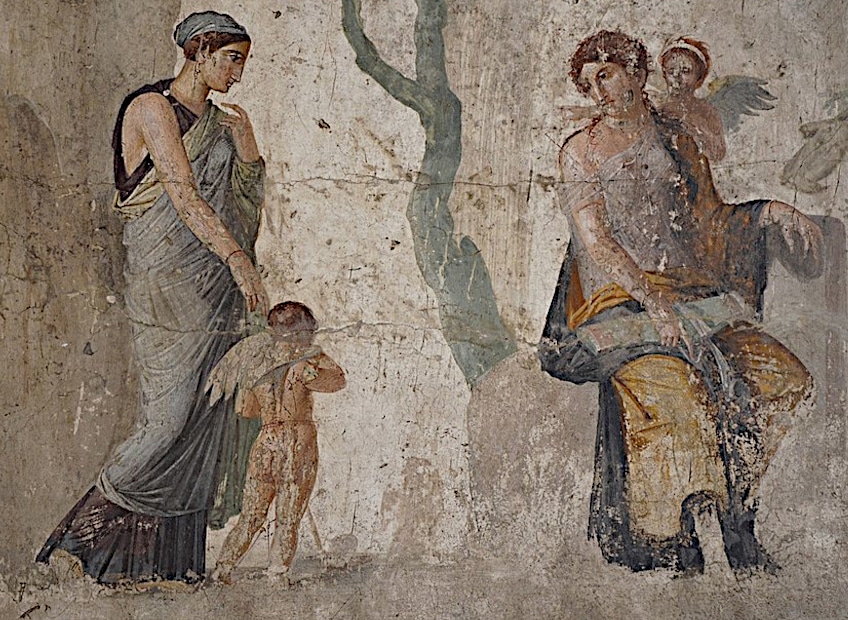 Fresco depicting a run-away Eros returned to his mother Aphrodite from the House of Punished love in Pompeii (c. 25 BCE); Carole Raddato from FRANKFURT, Germany, CC BY-SA 2.0, via Wikimedia Commons
Fresco depicting a run-away Eros returned to his mother Aphrodite from the House of Punished love in Pompeii (c. 25 BCE); Carole Raddato from FRANKFURT, Germany, CC BY-SA 2.0, via Wikimedia Commons
Iris
In ancient Greek mythology, Iris was the goddess of the rainbow and the Olympian gods’ messenger. She was also referred to as Hera’s personal handmaiden and messenger. Iris was a sky and sea goddess; her father Thaumas was a sea god, and her mother Elektra was a cloud nymph.
Because the rainbow’s arc was usually seen traversing the space between the sea and the clouds for the coastal Greeks, the goddess was thought to replace the rain clouds with seawater.
In ancient Greek vase artwork, Iris is represented as an exquisite young woman who has golden wings, a herald’s staff, and occasionally a water pitcher in her hand.
Hebe
In Greek mythology, Hebe was considered the goddess of youth, and she served as the cupbearer to the gods, serving ambrosia at the divine banquet. She was also regarded as the patron of newlyweds and one of Aphrodite’s attendants. Heracles married Hebe after ascending to Olympus, a marriage that reconciled the hero with his greatest adversary, Hebe’s mother Hera. Hebe was represented in Greek vase art as either Herakles’ partner or the gods’ cupbearer, dispensing ambrosia at their feasts on Olympus. When Zeus abducted the handsome Trojan prince Ganymede, he was made divine cupbearer in Hebe’s place.
 The Feast of the Gods by Giovanni Bellini and Titian (1514-1529); Giovanni Bellini, Public domain, via Wikimedia Commons
The Feast of the Gods by Giovanni Bellini and Titian (1514-1529); Giovanni Bellini, Public domain, via Wikimedia Commons
She had wings like the goddesses Nike and Iris in some depictions. Later stories identify her as the mother of two boys, Anticetus and Alexiares, and as a deity with the capacity to make the elderly young again. The goddess was worshiped in Rome by the name Juventas.
Hestia
Hestia was the ancient Greek virgin goddess of home and hearth. She oversaw the baking of bread and the preparation of the family meal. Hestia was also regarded as the Greek goddess of the sacrificial flame, and she received a small portion of all sacrifices that were made to the gods. Her domain inevitably included the preparation of the community feast of sacrificial meat. In Greek mythology, Hestia was Chronos and Rhea’s firstborn child, who was devoured by her father at birth.
When the gods Poseidon and Apollo requested her hand in marriage, Hestia rejected them and asked Zeus to help her stay a virgin forever. He agreed to it, and she tended the eternal fire in his hearth. In Athenian vase art, Hestia is portrayed as a modestly clothed woman holding onto a flowery branch. She was likewise covered in heavy clothing and veil in classical sculpture, and her symbol was a kettle.
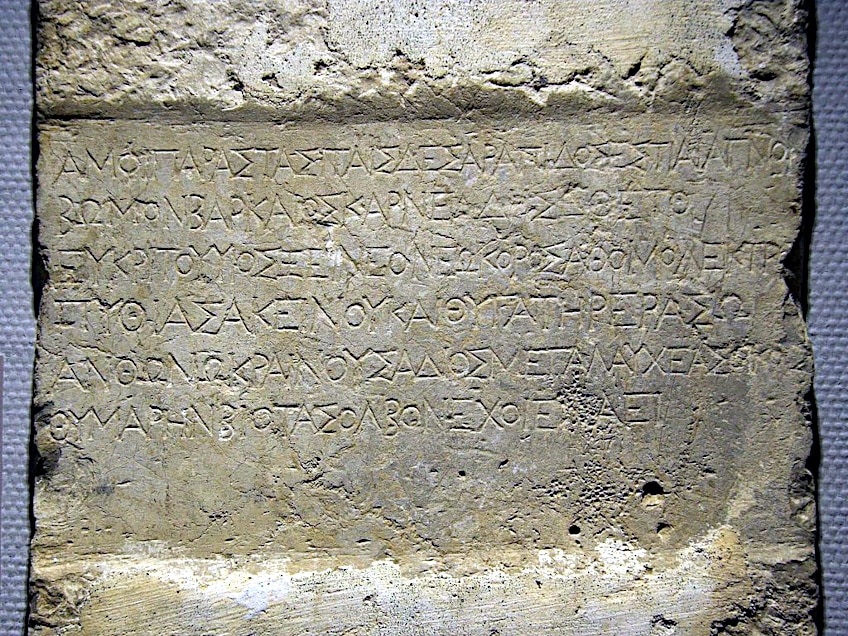 Inscription dedicating an altar to Hestia. It reads “Beside these walls of Serapis the warden of the temple Karneades of Barke, son of Eukritos, o foreigner, and his spouse Pythias and his daughter Eraso placed to Hestia a pure altar, as a reward for this, o you that governs the marvelous dwellings of Zeus, grant to them a lovely auspiciousness of life”; Zde, CC BY-SA 4.0, via Wikimedia Commons
Inscription dedicating an altar to Hestia. It reads “Beside these walls of Serapis the warden of the temple Karneades of Barke, son of Eukritos, o foreigner, and his spouse Pythias and his daughter Eraso placed to Hestia a pure altar, as a reward for this, o you that governs the marvelous dwellings of Zeus, grant to them a lovely auspiciousness of life”; Zde, CC BY-SA 4.0, via Wikimedia Commons
Leto
Leto was a Titanide, a female Titan, as well as Zeus’ partner, and the mother of Apollo and Artemis. Leto was the goddess of maternity and a protector of children along with her offspring.
Her name and iconography imply she was a goddess of humility and feminine modesty. Just like her sister Asteria, Leto might have been a goddess of the night. This makes sense given that her children were associated with the sun and the moon.
When Leto was pregnant with twins, the goddess Hera chased her mercilessly, driving her from land to land, and preventing her from locating a place where she could rest and give birth. She ultimately found refuge on the floating island of Delos. Leto was typically portrayed in Greek art as a woman removing her veil in a modest gesture, surrounded by her two children.
The Moirae
The Moirae were three fate goddesses who embodied man’s unavoidable fate. They assigned everyone a fate or a place in the grand scheme of things. The Moirae spun out the thread of a man’s future existence at his birth, tracked his movements, and guided the repercussions of his deeds in accordance with the advice of the gods. It was not an unchangeable fate; Zeus had the capacity to save even those who were on the verge of meeting their fate if he so desired.
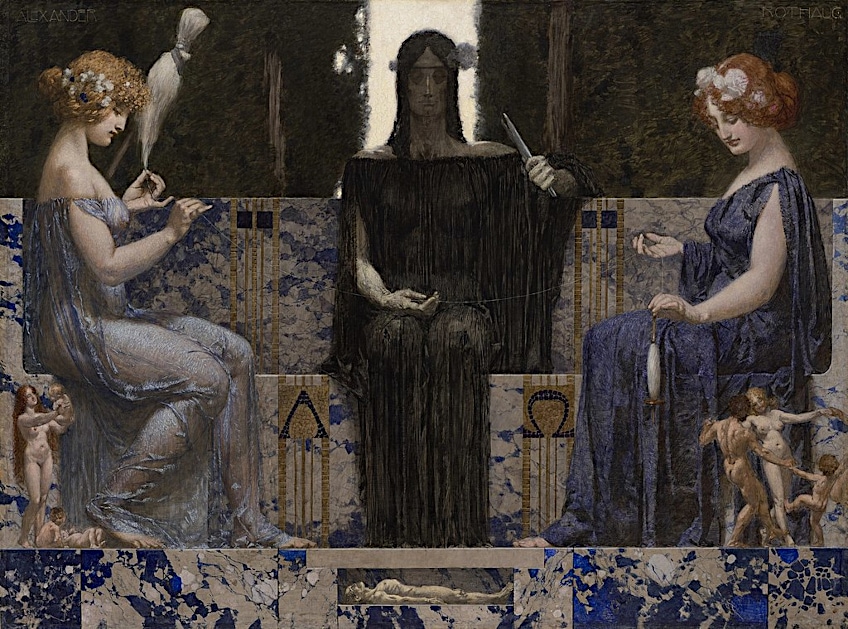 The Three Fates by Alexander Rothaug (c. 1910); Alexander Rothaug (Austria, 1870-1946), Public domain, via Wikimedia Commons
The Three Fates by Alexander Rothaug (c. 1910); Alexander Rothaug (Austria, 1870-1946), Public domain, via Wikimedia Commons
The Moirae were autonomous, they guided fate and ensured that the fate allocated to each living thing by eternal laws would run its course without any interference.
They delegated the appropriate tasks to the Erinyes, who administered punishment for evil conduct, and with them, they governed fate in accordance with the laws of necessity.
The Muses
The Muses comprised nine goddesses in Greek mythology who are the embodiments of both the sciences and the arts. They were thought to encourage human creativity, wisdom, and creative expression. They were the daughters of Zeus and the goddess of memory, Mnemosyne. Each of the Muses was linked with a certain domain of influence, and they inspired and guided people who worked in various fields.
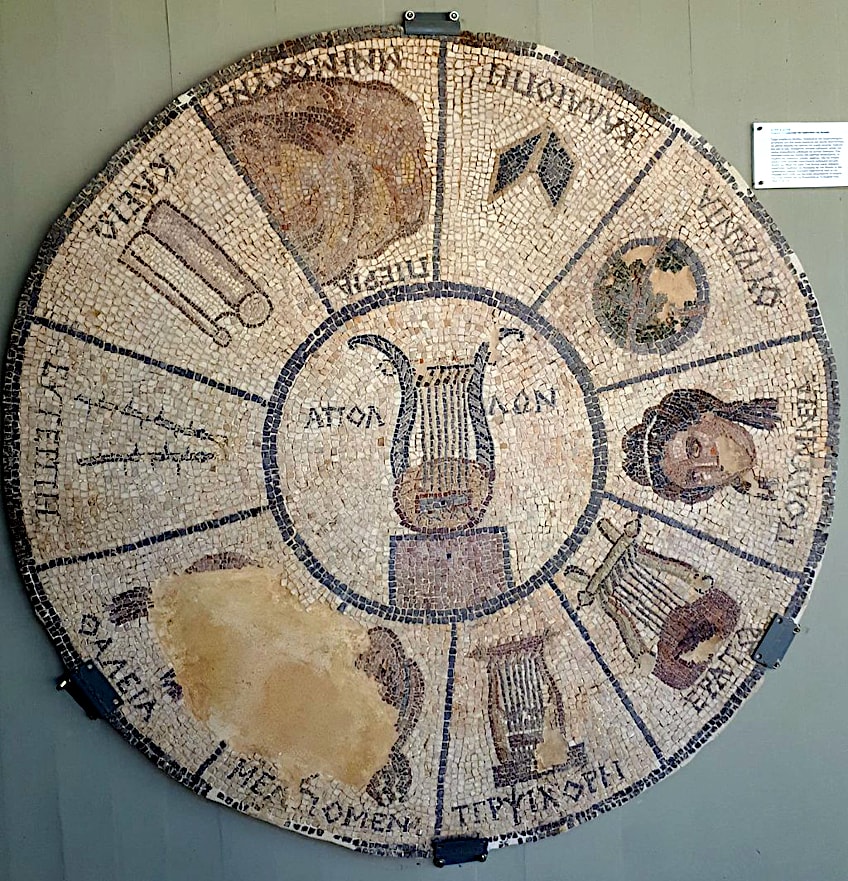 Mosaic disc with the symbols of the nine Muses, their mother Mnemosyne, and Apollo’s lyre in the center (1st Century BCE); Deiadameian, CC BY-SA 4.0, via Wikimedia Commons
Mosaic disc with the symbols of the nine Muses, their mother Mnemosyne, and Apollo’s lyre in the center (1st Century BCE); Deiadameian, CC BY-SA 4.0, via Wikimedia Commons
The Muses were portrayed as young maidens with immense knowledge and creative aptitude. They were portrayed in groups or escorting Apollo, the patron of the arts.
The Muses were important figures in ancient Greek culture, serving as a source of inspiration for singers, poets, artists, and academics. Their impact went beyond the arts to include astronomy, history, and philosophy, among other academic pursuits. The first recorded epic poem in Greek history opens with the line: “Sing Muse of the rage of Achilles”.
Nike
Nike was the winged goddess of triumph, both in combat and in sports. When Zeus was assembling companions for the Titan War, Styx enlisted the help of her four children. Nike was chosen as his charioteer, and the four became guardians of Zeus’ throne.
Nike was portrayed in ancient Greek art with an assortment of attributes such as a wreath or ribbon to crown a conqueror, a bowl and cup for libations, an incense burner, an altar, and a lyre for celebrating a triumph.
 Attic red-figure lekythos featuring a Winged Nike with a thymiaterion (c.490 BCE); Metropolitan Museum of Art, CC BY 2.5, via Wikimedia Commons
Attic red-figure lekythos featuring a Winged Nike with a thymiaterion (c.490 BCE); Metropolitan Museum of Art, CC BY 2.5, via Wikimedia Commons
Nike features as Zeus’ charioteer in episodes from the War of the Giants. She is frequently shown holding a branch of the palm tree as an emblem of triumph in mosaic art and coinage. Gods such as Zeus and Athena were also portrayed holding a small winged Nike in the palm of their outstretched hands.
Themis
Themis was the goddess of cosmic law and order, the first guidelines for behavior established by the gods. She also served as a prophetic goddess who ruled over ancient oracles such as Delphi. In her position, she was the heavenly voice that first taught people the fundamental principles of morality and equity, such as piety, hospitality guidelines, good government, forum conduct, and religious sacrifices to the gods.
Themis was Zeus’ first wife and his first adviser. She often appeared seated alongside his throne, instructing him on the laws of the universe and fate’s decrees.
Tyche
Tyche was considered the Greek goddess of luck, chance, destiny, and providence. Tyche was portrayed with an array of attributes: grasping a rudder, she was believed to be the divinity in charge of directing and managing the affairs of the world. When portrayed with a ball, she represented the fluctuating unpredictability of fortune as it was unstable with the ability to roll in any direction. When portrayed with the cornucopia, she was the representation of the abundance of gifts of good fortune.
Along with her Roman counterpart Fortuna and Hellenistic period syncretic variants such as Isis-Fortuna, the worship of this goddess was widespread and enthusiastic.
 Marble relief and mosaic depictions of Tyche (6th Century CE); Israel Museum, CC0, via Wikimedia Commons
Marble relief and mosaic depictions of Tyche (6th Century CE); Israel Museum, CC0, via Wikimedia Commons
That completes our list of Mount Olympus gods. This not only includes the 12 Olympian gods and goddesses, but also the other lesser deities that are connected to Olympus. To the ancient Greeks, each of these gods could be called upon to serve in their various capacities and help humans through challenging times. Whether it was for war or birth, life or death, or even love, the gods of Olympus were able to bring peace, justice, and vengeance to humanity.
Frequently Asked Questions
Why Were the Greek Gods Called Olympians?
The Olympian gods took their name from Mount Olympus, the highest peak in ancient Greece. This elevated vantage point enabled them to see everything that happened below. The major gods of the Greek pantheon who had overthrown the previous generation of gods called Titans, established homes on Olympus under the leadership of the sky-god Zeus. The Olympian gods were not confined to Olympus though, but also spent time in their temples and sacred precincts, when not wandering around in disguise.
What Is the Difference Between Roman and Greek Gods?
Much of ancient Roman culture was influenced by the preceding Greeks. It was not unusual for ancient peoples to identify aspects of their own gods with those of the cultures they encountered. The Romans appropriated major elements of Greek literature, meaning that the gods of Rome typically share most of the same attributes as their Greek counterparts, with a few adaptations to better suit the Roman way of thought and life.

I am deeply passionate about history and am constantly fascinated by the rich and complex stories of the past. As the editor-in-chief of learning-history.com, I have the opportunity to share this passion with a wide audience through the creation and distribution of engaging and informative content about historical events, persons, and cultures. Whether it’s through writing articles and blog posts or creating videos or podcasts, I strive to bring the past to life in a way that is both accurate and enjoyable. My expertise in history, combined with my strong writing and communication skills, allows me to effectively communicate complex historical concepts and make them accessible and interesting to a wide range of readers. I am truly grateful for the opportunity to share my love of history with others through my work on learning-history.com.







